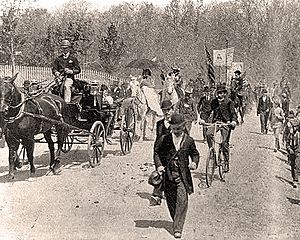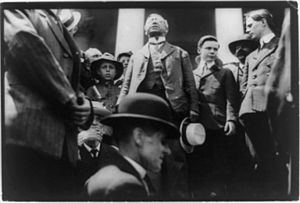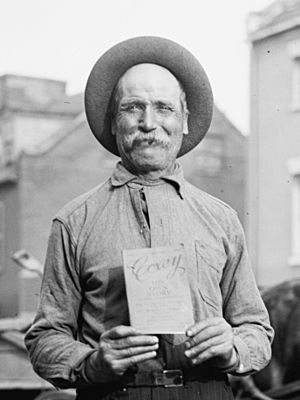Coxey's Army facts for kids
Coxey's Army was a group of unemployed people in the United States. They marched to Washington, D.C. in 1894. This march was led by an Ohio businessman named Jacob Coxey.
The march happened during a very bad economic time. It was called the Panic of 1893. This economic downturn lasted four years. It was the worst in U.S. history up to that point. The group's official name was the Army of the Commonwealth in Christ. But everyone called them Coxey's Army after their leader. This was the first big protest march to Washington, D.C. The saying "Enough food to feed Coxey's Army" comes from this event.
Contents
The First March: A "Petition in Boots"
The march was called a "petition in boots." Its main goal was to protest against the many people who had lost their jobs. This job loss was caused by the Panic of 1893. The marchers wanted the government to create new jobs. These jobs would involve building roads and other public projects. They also wanted workers to be paid with new paper money. This idea was popular with a group called the Populists.
The march began with about 100 men. They started in Massillon, Ohio, on March 25, 1894. They walked through places like Pittsburgh and Homestead, Pennsylvania.
Other Groups Join the March

Other groups from around the country joined the march. One group from California was called Kelley's Army. It was led by "General" Charles T. Kelley. Another group, Fry's Army, started in Los Angeles.
By April 30, 1894, about 500 marchers reached Washington, D.C. Many more were still on their way. About 6,000 jobless men camped at a large farm site. This site is now Colmar Manor, Maryland.
Arrests and End of the First March
The very next day, Jacob Coxey and other leaders were arrested. They were arrested for walking on the grass at the United States Capitol. After the arrests, interest in the march quickly faded. Even though it did not achieve its immediate goals, it was important. It was the first major protest march on Washington, D.C.
Railroad Protests in the West
Some of the most determined Coxey supporters formed their own "armies." These groups were in places like Butte, Montana, Tacoma, Washington, and Portland, Oregon. Many of these protesters were unemployed railroad workers. They blamed railroad companies and President Grover Cleveland for their problems.
One notable event happened on April 21, 1894. William Hogan and about 500 followers took over a Northern Pacific Railway train. They wanted to ride it to Washington, D.C. They got support along the way. This helped them fight off federal officers trying to stop them. Finally, federal troops caught the Hoganites near Forsyth, Montana. The protesters never made it to the capital. However, the military action against them was a practice run. Federal forces later broke the Pullman Strike that same year.
The Second March in 1914
Jacob Coxey organized a second march. This march took place in 1914. Part of this march reached Monessen, Pennsylvania, on April 30. Another group from New York City joined them.
When the march arrived in Washington, D.C., Coxey spoke to his supporters. He gave his speech from the steps of the United States Capitol.
Legacy of Coxey's Army
Coxey's idea for government jobs was quite new for its time. However, it later became part of U.S. federal policy. This happened with the passing of the New Deal programs. On May 1, 1944, Coxey was even asked to read his original petition again. He read it from the steps of the Capitol.
More importantly, marches on Washington became a popular way for people to protest. They used these marches to show their unhappiness with the government or its policies.
Coxey's Army in Culture
Many people watched the first march. One observer was L. Frank Baum, who later became famous. He wrote the book The Wonderful Wizard of Oz. Some people believe there are hidden meanings in his book related to Coxey's Army.
In the story, Dorothy, the Scarecrow, the Tin Woodman, and the Cowardly Lion march. They walk on the yellow brick road to the Emerald City. This city is like Washington, D.C. They demand help from the Wizard, who is like the President. Dorothy's silver shoes in the book are thought to represent using free silver. This was an idea to help the economy instead of relying on the gold standard. The gold standard is like the yellow brick road. A shortage of gold led to the Panic of 1893. In the movie The Wizard of Oz, the silver shoes were changed to ruby. This was done for the bright colors of Technicolor film.
The phrase "Coxey's Army" can also mean a disorganized group of people. This meaning might come from an event during the second march in 1914.
Coxey's Army is also mentioned in some books and plays:
- In Garet Garrett's book The Driver, a journalist follows the march.
- Jack London wrote about his own experiences. He was part of Kelley's Army. His story "Two Thousand Stiffs" is in his 1907 book The Road. He describes why the unemployed people marched. He also writes about how they were organized.
- In the 1955 play Inherit the Wind, a character mentions Coxey's Army.
- The 2016 historical mystery novel A March To Remember by Anna Loan-Wilsey uses Coxey's Army's arrival in Washington D.C. as its setting.
The saying "Enough food to feed Coxey's Army" means there is much more food than needed.
Laura Ingalls Wilder also mentions Coxey's armies in her book "On the Way Home." She writes about them during the Panic of 1893. She describes them taking over trains and looking for food. She remembered federal troops guarding buildings in cities. Her book is a diary of her family's trip in 1894.
|




